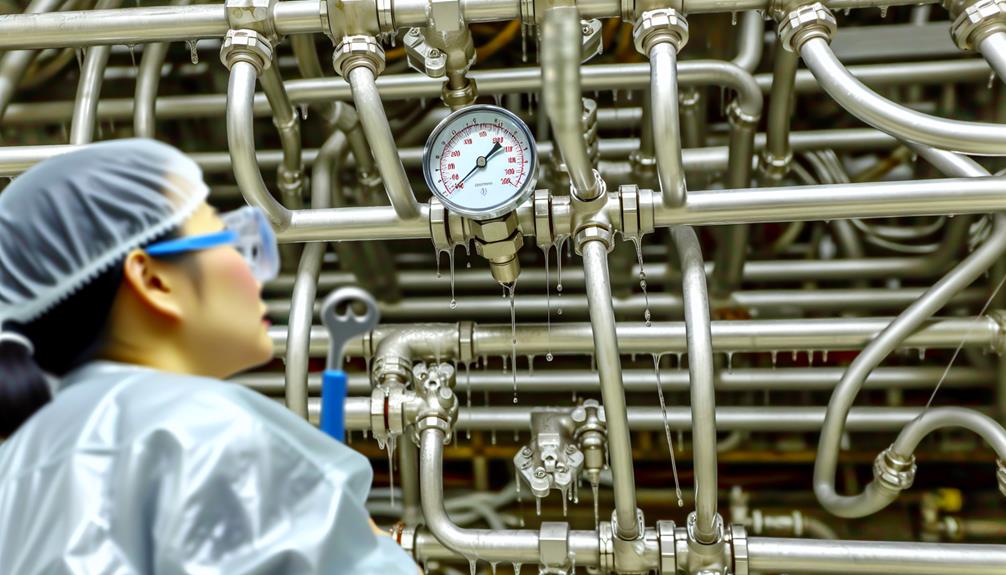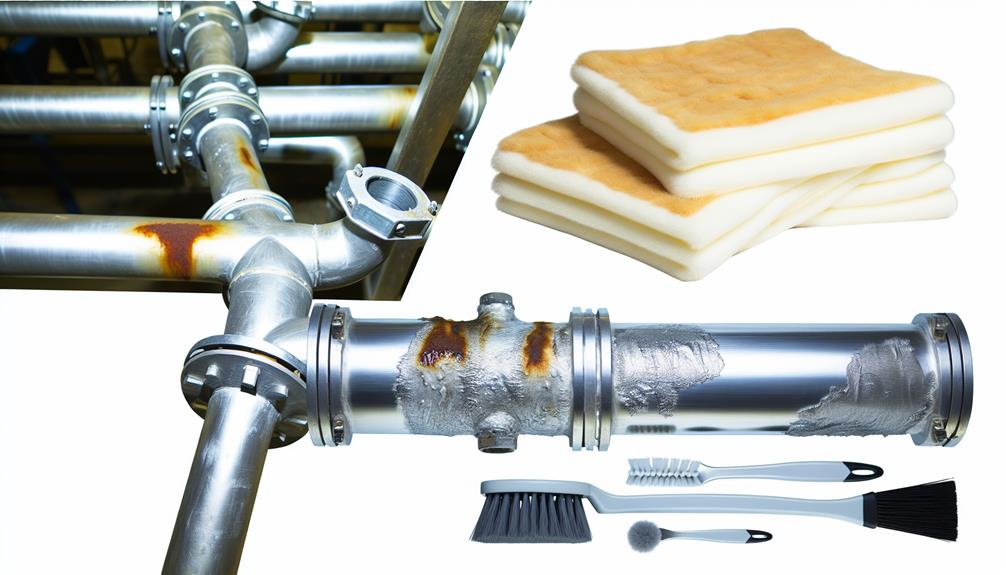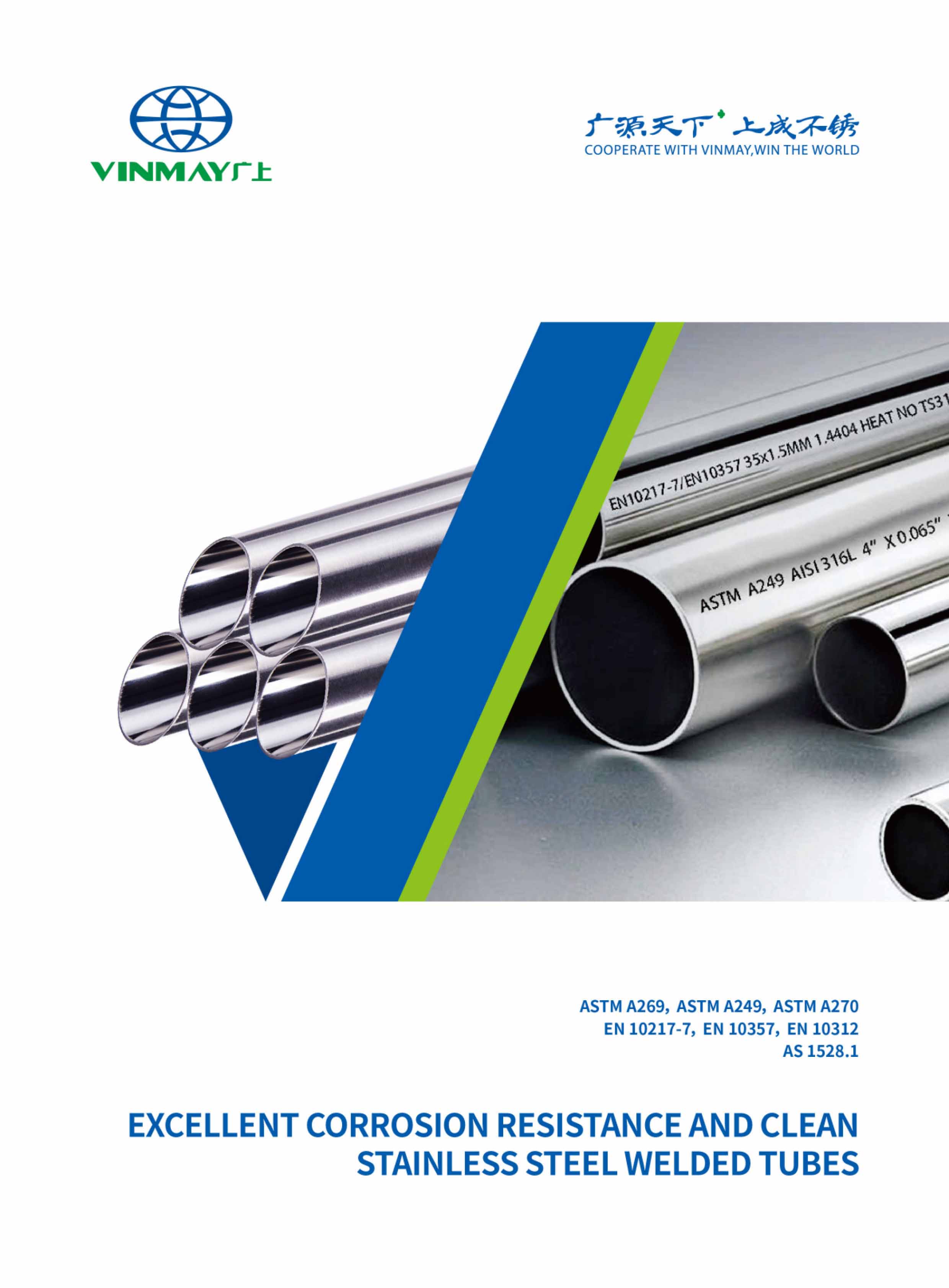In the realm of sanitary stainless steel tube systems, encountering operational hitches is not uncommon. From pesky leaks that threaten system integrity to the unwelcome presence of corrosion, each challenge demands a methodical approach to resolution.
As professionals dedicated to ensuring the smooth functioning of these critical systems, a deep dive into common issues and their corresponding solutions becomes imperative. Join us as we unravel the intricacies of troubleshooting 101, shedding light on the nuances that can make all the difference in maintaining the optimal performance of these stainless steel marvels.

In sanitary stainless steel tube systems, instances of leaks and seepage can be indicative of underlying issues that require prompt attention and thorough investigation. Maintaining seal integrity is paramount to prevent leaks in these systems. Regular maintenance procedures, such as inspecting seals for wear and tear, tightening connections, and replacing damaged seals promptly, can help ensure the integrity of the system.
To maintain seal integrity, it is essential to follow proper maintenance procedures diligently. This includes conducting regular inspections to check for any signs of leaks or seepage, especially at connection points and joints. Implementing a preventive maintenance schedule can help detect potential issues before they escalate into significant leaks, minimizing downtime and costly repairs.
Additionally, it is crucial to use high-quality seals that are compatible with the specific operating conditions of the sanitary stainless steel tube system. Choosing the right seals and following recommended installation practices can significantly reduce the risk of leaks and ensure the system operates efficiently. By prioritizing seal integrity and adhering to maintenance procedures, the likelihood of leaks and seepage in sanitary stainless steel tube systems can be minimized.
Instances of blockages and build-up in sanitary stainless steel tube systems can impede the flow of fluids and compromise system functionality, necessitating proactive measures to address these issues promptly. Preventing blockages is crucial to maintaining the efficiency of the system. Regular inspection and cleaning schedules can help prevent the accumulation of debris, sediment, or microbial growth that could lead to blockages. Utilizing filters and strainers at strategic points in the system can also help trap particles before they cause obstructions.
When build-up occurs, timely build-up removal is essential. Chemical cleaning agents or mechanical methods such as pigging can be employed to dislodge and remove deposits from the interior of the tubes. Implementing a thorough cleaning protocol as part of routine maintenance can significantly reduce the likelihood of build-up formation. Additionally, ensuring proper velocities within the tubes can prevent solids from settling and accumulating. By implementing these preventive measures and promptly addressing any build-up issues, the integrity and efficiency of sanitary stainless steel tube systems can be preserved.

Temperature fluctuations within sanitary stainless steel tube systems can significantly impact the performance and integrity of the system components. Proper management of temperature changes is crucial to ensure the system operates efficiently and maintains its structural integrity.
Here are some key considerations when dealing with temperature fluctuations:
Read More: Stainless Steel Tube for Heat Exchanger
Understanding the impact of corrosion and rust on sanitary stainless steel tube systems is imperative for maintaining system integrity and performance. Corrosion can weaken the structural integrity of the tubes, leading to leaks or system failures. Rust, a form of corrosion specific to iron and steel, can also contaminate the system's contents if not addressed promptly.
To prevent corrosion and rust, proper preventive maintenance measures must be implemented. Regular inspections, cleaning, and corrosion-resistant coatings can significantly extend the lifespan of stainless steel tubes. Additionally, material selection plays a crucial role in mitigating corrosion risks. Choosing high-quality stainless steel grades with superior corrosion resistance properties, such as 316L or 304 stainless steel, can enhance the system's durability and longevity.

When dealing with pressure irregularities in sanitary stainless steel tube systems, it is crucial to employ effective leak detection methods to pinpoint any potential sources of leaks.
Additionally, ensuring the accuracy and functionality of pressure gauges is essential for maintaining system integrity and performance.
Utilizing pressure irregularities as a key indicator, leak detection methods play a crucial role in maintaining the integrity of sanitary stainless steel tube systems. When troubleshooting leaks, several methods can be employed:
These methods allow for comprehensive leak detection, ensuring the system's reliability and safety.
Continuously monitoring and maintaining the correct pressure gauge is imperative for identifying pressure irregularities within sanitary stainless steel tube systems.
Calibration accuracy is paramount to ensure the pressure gauge provides precise readings. Regular calibration checks should be performed according to manufacturer guidelines to guarantee accuracy.
When installing a pressure gauge, adherence to installation guidelines is crucial to prevent inaccuracies that could lead to misinterpretation of pressure levels. Proper installation includes ensuring the gauge is mounted securely, free from vibrations, and in a location easily visible for monitoring.
Following these installation guidelines and regularly checking calibration accuracy will help maintain a reliable pressure gauge, allowing for prompt detection and resolution of pressure irregularities in sanitary stainless steel tube systems.
Welding defects in sanitary stainless steel tube systems can compromise the integrity and performance of the overall system, necessitating thorough inspection and prompt resolution. When dealing with welding defects, it is crucial to consider various factors, including welding techniques and material compatibility.
Here are five common welding defects to watch out for:
Regular inspection and adherence to proper welding procedures are essential to prevent these defects and ensure the longevity of sanitary stainless steel tube systems.
Recommended: Sanitary Stainless Steel Welding

Surface contamination poses a significant risk to the functionality and hygiene of sanitary stainless steel tube systems, warranting meticulous attention to cleanliness protocols and material handling practices. The presence of contaminants such as dirt, grease, or chemical residues on the surface of stainless steel tubes can compromise their integrity, leading to corrosion, bacterial growth, and potential product contamination. To mitigate these issues, thorough cleaning techniques must be employed regularly to ensure the removal of all foreign substances. Utilizing appropriate cleaning agents and methods specified for stainless steel surfaces is essential to maintain the system's cleanliness and prevent contamination.
Moreover, material selection plays a crucial role in preventing surface contamination in sanitary stainless steel tube systems. Choosing high-quality stainless steel grades with excellent corrosion resistance and smooth surface finishes can reduce the risk of contamination and facilitate easier cleaning processes. By selecting the appropriate materials and adhering to stringent cleaning protocols, the integrity and hygiene of sanitary stainless steel tube systems can be effectively preserved.
The presence of vibration and noise within sanitary stainless steel tube systems can impact their performance and longevity, necessitating careful assessment and mitigation strategies.
Discoloration on sanitary stainless steel tubes may result from improper surface treatment or corrosive environments. Temperature control during welding is vital to prevent oxidation. Utilizing advanced welding techniques enhances corrosion resistance, maintaining the tubes' aesthetics.
To prevent galling in stainless steel tube systems, focus on surface finish improvement. Utilize techniques like electropolishing or passivation to create a smoother surface, reducing friction and minimizing the risk of galling. Prioritize quality maintenance to ensure long-term system durability.
Cleaning techniques are crucial for maintaining sanitary stainless steel tubes. Regular cleaning with appropriate solutions removes contaminants, preventing corrosion. Passivation, a process that enhances corrosion resistance, should be performed periodically to maintain the integrity of the system.
Potential consequences of inadequate support for stainless steel tube systems include structural failure, leaks, and safety hazards. Improper support can lead to vibration-induced fatigue, stress corrosion cracking, and increased maintenance costs. Addressing support issues promptly is critical.
To determine the root cause of vibration and noise in a stainless steel tube system, conduct a thorough vibration analysis. Identify potential sources of vibration such as unbalanced components or improper support. Implement noise reduction strategies like damping materials or isolation techniques for effective mitigation.
In conclusion, troubleshooting common issues in sanitary stainless steel tube systems requires a systematic approach. This approach addresses leaks, blockages, temperature fluctuations, corrosion, pressure irregularities, welding defects, surface contamination, and vibration. By identifying and resolving these issues promptly, system efficiency and performance can be maintained at optimal levels. This ensures the longevity and reliability of the system.
Regular maintenance and monitoring are essential to prevent future issues and ensure smooth operation.
Blog Series: Troubleshooting 101: Common Issues and Solutions for Sanitary Stainless Steel Tube Systems


